文章目录
1.list的介绍
list是可以在常数范围内在任意位置进行插入和删除的序列式容器,并且该容器可以前后双向迭代。list的底层是双向链表结构,双向链表中每个元素存储在互不相关的独立节点中,在节点中通过指针指向 其前一个元素和后一个元素。list与forward_list非常相似:最主要的不同在于forward_list是单链表,只能朝前迭代,已让其更简单高效。- 与其他的序列式容器相比
(array,vector,deque),list通常在任意位置进行插入、移除元素的执行效率更好。- 与其他序列式容器相比,
list和forward_list最大的缺陷是不支持任意位置的随机访问,比如:要访问list的第6个元素,必须从已知的位置(比如头部或者尾部)迭代到该位置,在这段位置上迭代需要线性的时间开销;list还需要一些额外的空间,以保存每个节点的相关联信息(对于存储类型较小元素的大list来说这可能是一个重要的因素)
2.list的使用
template < class T, class Alloc = allocator<T> > class list;
//list的使用需要使用显示实例化才能使用
2.1list的构造函数
list (size_type n, const value_type& val = value_type())//构造的list中包含n个值为val的元素
list()//构造空的list
list (const list& x)//拷贝构造函数
list (InputIterator first, InputIterator last)//用[first, last)区间中的元素构造list
eg:
void testlist1()
{
list<int> lt1;
list<int> lt2(10, 6);
for (auto e : lt2)
{
cout << e << " ";
}
cout<<endl;
list<int> lt3(lt2);
for (auto e : lt3)
{
cout << e << " ";
}
cout << endl;
list<int> lt4(lt3.begin(), lt3.end());
for (auto e : lt4)
{
cout << e << " ";
}
cout << endl;
}
代码运行结果为:

2.2list modifiers
void push_front (const value_type& val);
//在首元素前插入值为val的元素
void pop_front();
//删除val的第一个元素
void push_back (const value_type& val);
//在list的尾部插入值为val的
void pop_back();
//删除list中最后一个元素
single element (1)
iterator insert (iterator position, const value_type& val);
//在list position位置插入值为val的元素
fill (2)
void insert (iterator position, size_type n, const value_type& val);
//在list position的位置插入n个值为val的元素
range (3)
template <class InputIterator>
void insert (iterator position, InputIterator first, InputIterator last);
//在list position的位置插入[first,last]区间的元素
iterator erase (iterator position);
//删除position位置的值
iterator erase (iterator first, iterator last);
//删除[first,last)区间的元素
void swap (list& x);
//交换两个list中的元素
void clear();
//清空list中的数据
eg1:
void testlist2()
{
list<int> lt1;
lt1.push_back(10);
lt1.push_back(20);
lt1.push_back(30);
lt1.push_back(40);
lt1.push_back(50);
lt1.push_back(60);
for (auto& e : lt1)
{
cout << e << " ";
}
cout << endl;
lt1.pop_front();
for (auto& e : lt1)
{
cout << e << " ";
}
cout << endl;
lt1.push_front(100);
for (auto& e : lt1)
{
cout << e << " ";
}
cout << endl;
lt1.pop_back();
for (auto& e : lt1)
{
cout << e << " ";
}
cout << endl;
}
代码编译运行的结果为:
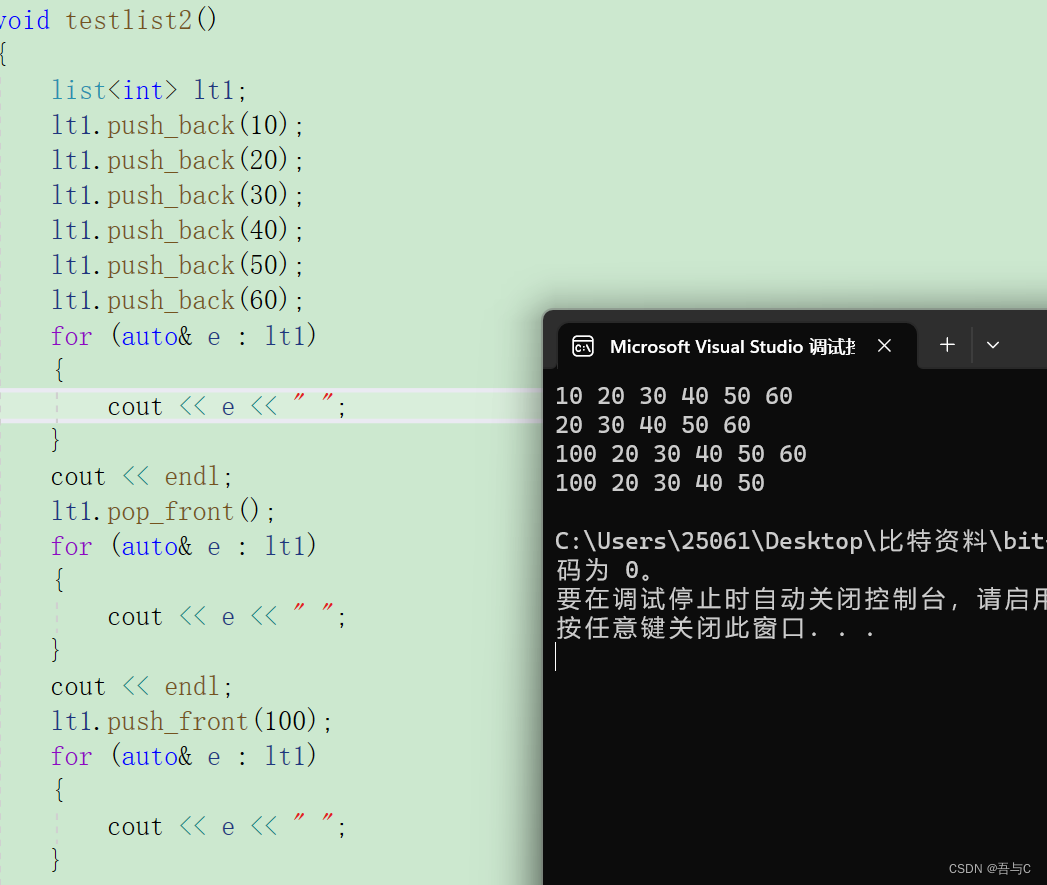
eg2:
void testlist3()
{
list<int> lt1;
lt1.push_back(10);
lt1.push_back(20);
lt1.push_back(30);
lt1.push_back(40);
lt1.push_back(50);
lt1.push_back(60);
list<int>::iterator it = lt1.begin();
//在it位置插入99
lt1.insert(it, 99);
for (auto& e : lt1)
{
cout << e << " ";
}
cout << endl;
it = lt1.begin();
//在it位置插入5个6
lt1.insert(it, 5, 6);
for (auto& e : lt1)
{
cout << e << " ";
}
cout << endl;
it = lt1.begin();
list<int> lt2(6, 5);
lt1.insert(it, lt2.begin(), lt2.end());
for (auto& e : lt1)
{
cout << e << " ";
}
cout << endl;
}
代码编译运行的结果为:
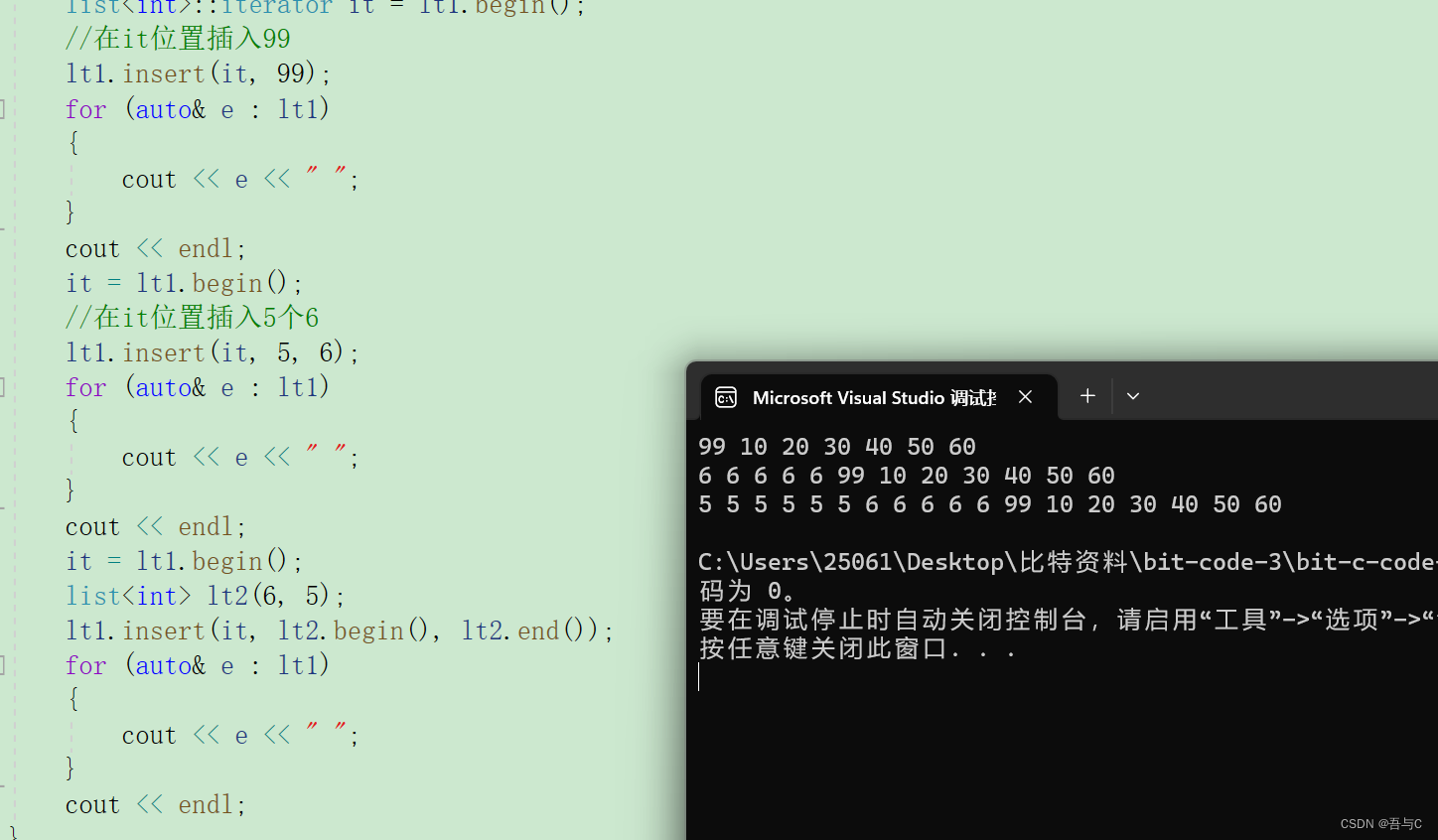
eg3:
void testlist4()
{
list<int> lt1;
lt1.push_back(10);
lt1.push_back(20);
lt1.push_back(30);
lt1.push_back(40);
lt1.push_back(50);
lt1.push_back(60);
list<int>::iterator it = lt1.begin();
lt1.erase(it);
for (auto& e : lt1)
{
cout << e << " ";
}
cout << endl;
lt1.erase(lt1.begin(), lt1.end());
for (auto& e : lt1)
{
cout << e << " ";
}
cout << endl;
}
代码编译运行的结果为:
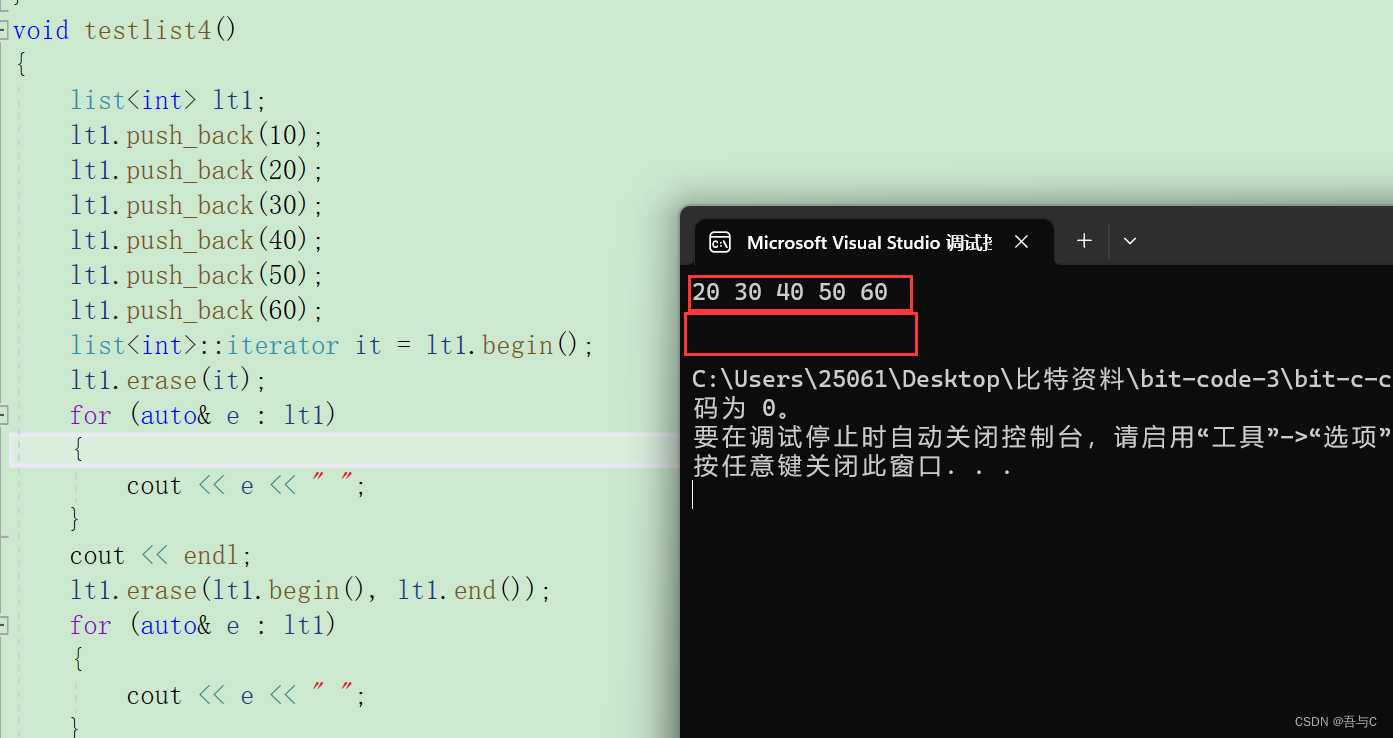
eg4:
void testlist5()
{
list<int> lt1;
lt1.push_back(10);
lt1.push_back(20);
lt1.push_back(30);
lt1.push_back(40);
lt1.push_back(50);
lt1.push_back(60);
list<int> lt2(5, 6);
printf("lt1的当前元素:");
for (auto& e : lt1)
{
cout << e << " ";
}
cout << endl;
printf("lt2的当前元素:");
for (auto& e : lt2)
{
cout << e << " ";
}
cout << endl;
swap(lt1, lt2);
printf("lt1的当前元素:");
for (auto& e : lt1)
{
cout << e << " ";
}
cout << endl;
printf("lt2的当前元素:");
for (auto& e : lt2)
{
cout << e << " ";
}
cout << endl;
}
代码编译运行的结果为:
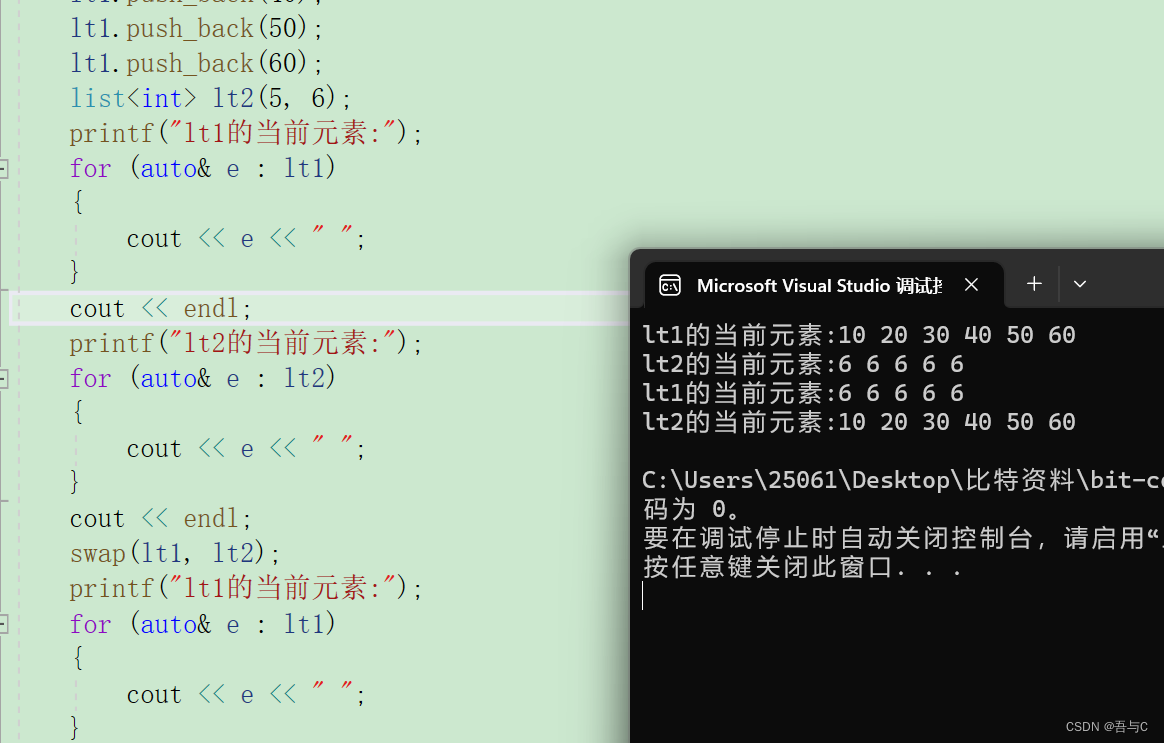
eg5:
void testlist6()
{
list<int> lt1;
lt1.push_back(10);
lt1.push_back(20);
lt1.push_back(30);
lt1.push_back(40);
lt1.push_back(50);
lt1.push_back(60);
for (auto& e : lt1)
{
cout << e << " ";
}
cout << endl;
//清空lt1原有数据后插入66
lt1.clear();
lt1.push_back(66);
for (auto& e : lt1)
{
cout << e << " ";
}
cout << endl;
}
代码编译运行的结果为:

2.3list capacity
bool empty() const;
//检测list是否为空,是返回true,否则返回false
size_type size() const;
//返回list中有效节点的个数
2.4list elment access
reference front();
const_reference front() const;
//返回list的第一个节点中值的引用
reference back();
const_reference back() const;
//返回list的最后一个节点中值的引用
eg1:
void testlist7()
{
list<int> lt1;
lt1.push_back(10);
lt1.push_back(20);
lt1.push_back(30);
lt1.push_back(40);
lt1.push_back(50);
lt1.push_back(60);
cout << "list头部元素为:" << lt1.front() << endl;
cout << "list尾部元素为:" << lt1.back() << endl;
}
代码运行的结果为:
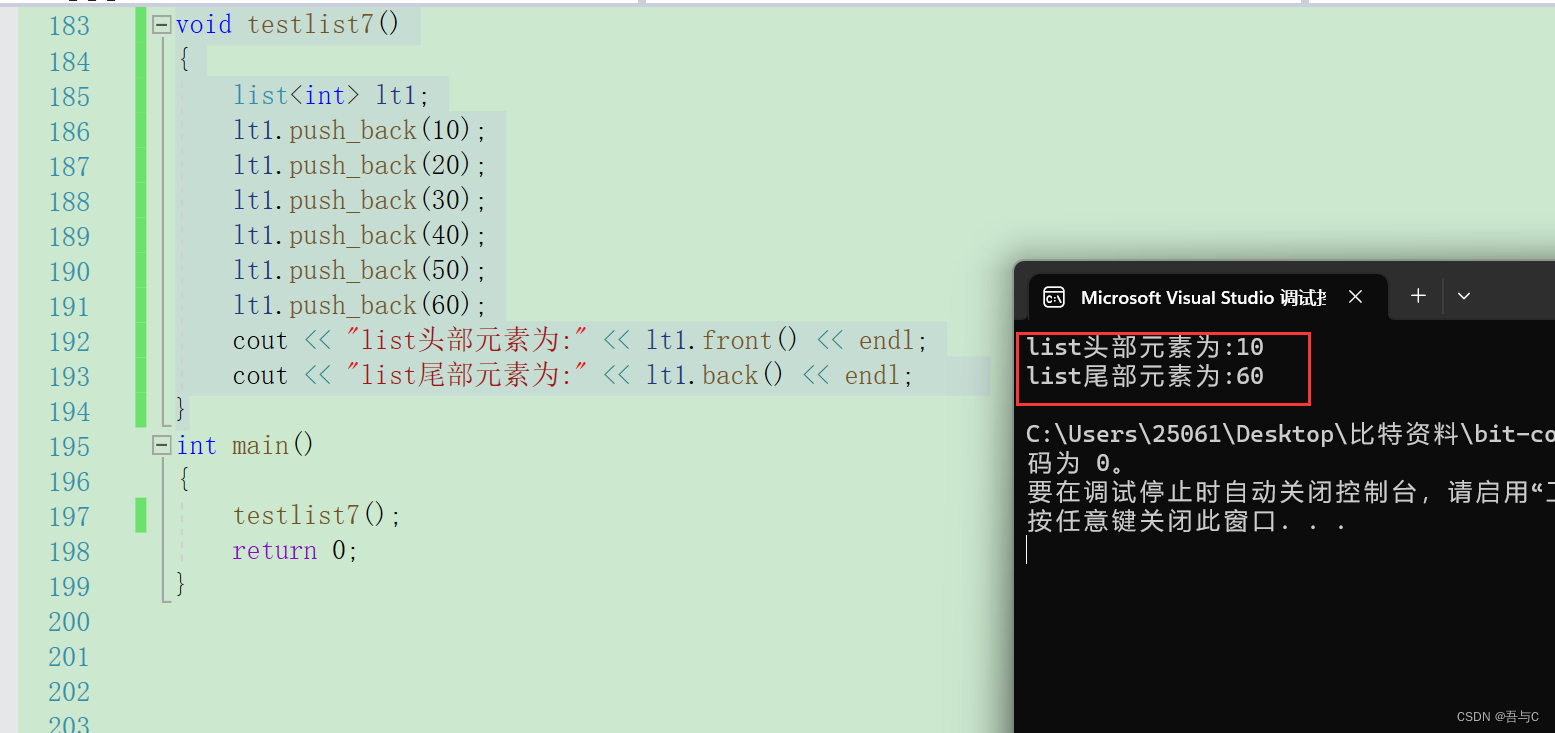
2.5iterator的使用
iterator begin();
const_iterator begin() const;
//返回第一个元素的迭代器
iterator end();
const_iterator end() const;
//返回最后一个元素下一个位置的迭代器
reverse_iterator rbegin();
const_reverse_iterator rbegin() const;
//返回第一个元素的reverse_iterator,即end位置
reverse_iterator rend();
const_reverse_iterator rend() const;
//返回最后一个元素下一个位置的reverse_iterator,即begin位置
list容器使用迭代器
void testlist8()
{
list<int> lt1(5, 6);
list<int>::iterator it = lt1.begin();
while (it != lt1.end())
{
cout << *it <<" ";
it++;
}
cout << endl;
}
代码运行的结果为:
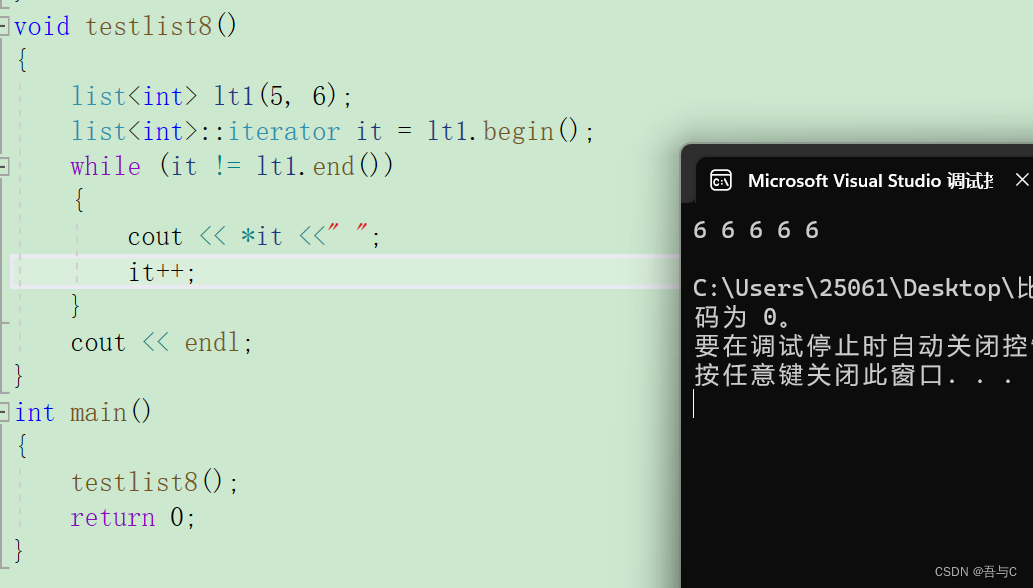
迭代器分类:
input iterator//输入迭代器
output iterator//输出迭代器
forward iterator//单向迭代器可以++ 适用forward_list/unorderd_xxx容器
bidirectional iterator//双向迭代器可以++/-- 适用list/map/set容器
random access iteartor//任意迭代器可以++/--/+/- 适用于vector/string/deque容器
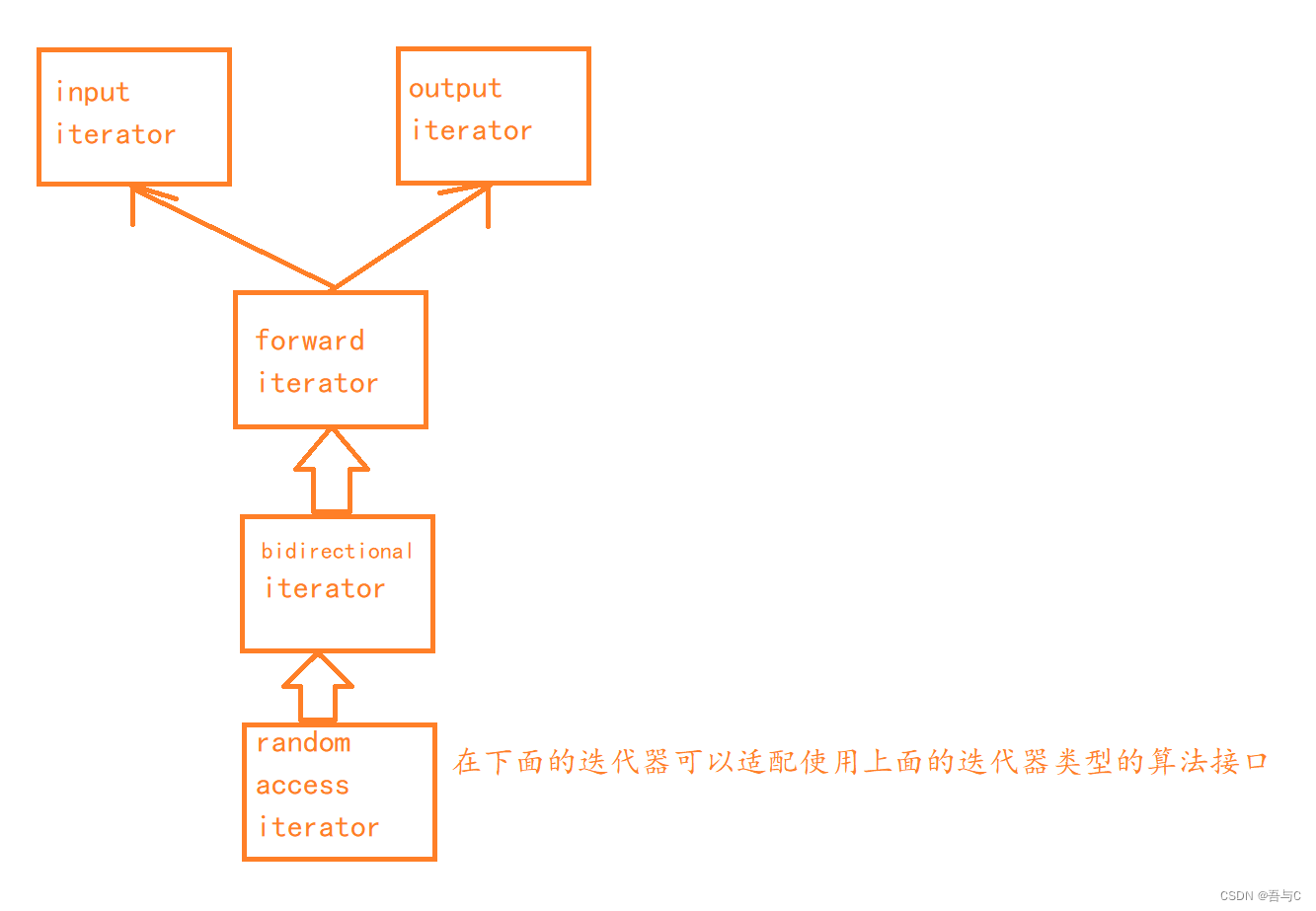
随机迭代器可以使用双向迭代器,反之双向迭代器不可以使用随机迭代器!较多功能的容器迭代器可以使用适配较少功能的迭代器的算法接口函数,反之则不可以!
栗子:
list的迭代器为:
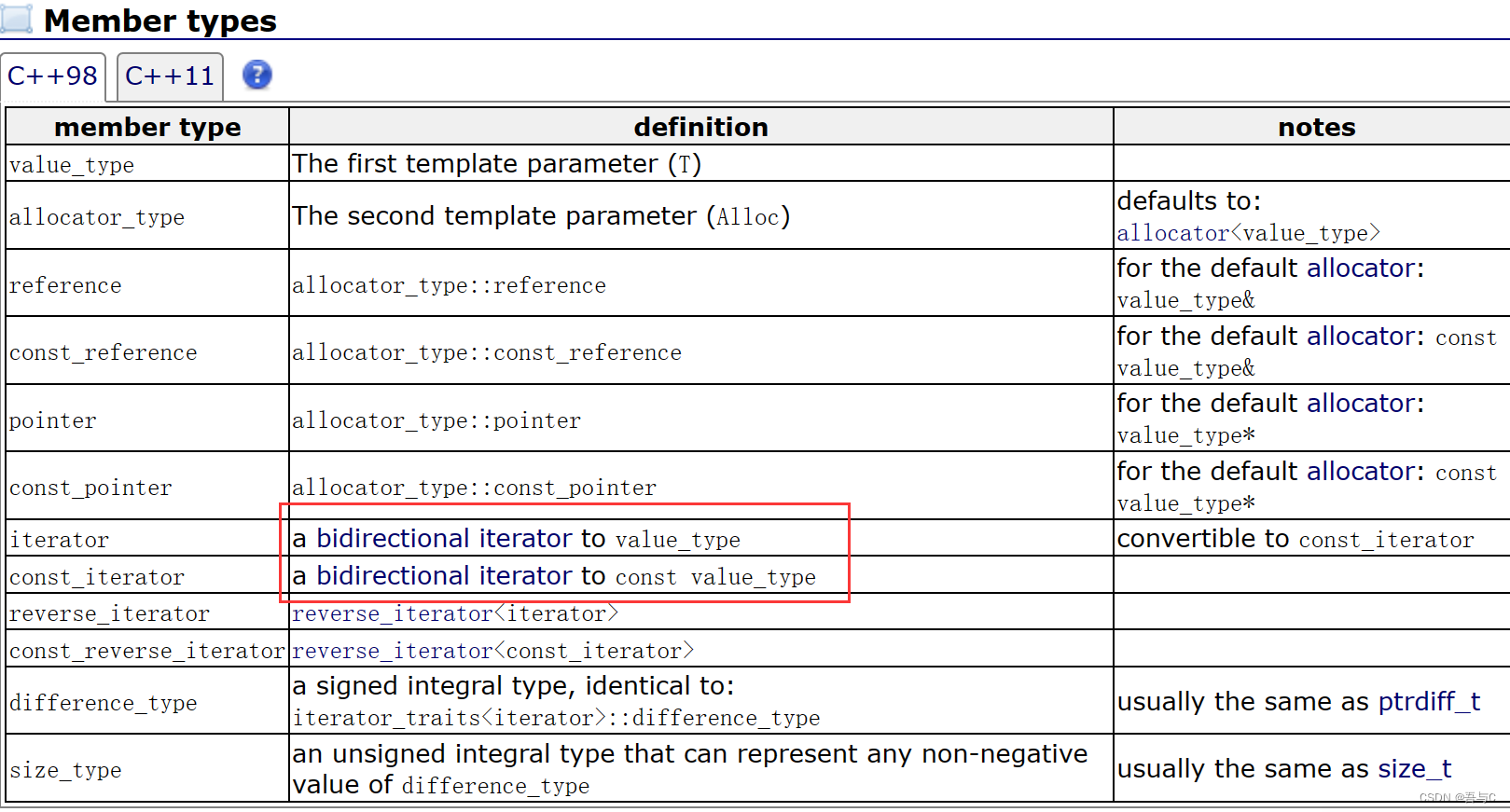
算法接口函数为:


void testlist9()
{
list<int> lt1;
lt1.push_back(16);
lt1.push_back(8);
lt1.push_back(99);
lt1.push_back(18);
lt1.push_back(36);
lt1.push_back(6);
//不可以使用algorithm
//sort(lt1.begin(), lt1.end());
//可以使用list自己的sort进行排序
lt1.sort();
for (auto& e : lt1)
{
cout << e << " ";
}
cout << endl;
}
代码编译运行的结果为:

list的迭代器为双向迭代器,不能使用算法接口函数中适配任意迭代器的sort函数,只能使用list的sort函数。
3.list的模拟实现
3.1list的源码
#pragma once
#include<iostream>
using namespace std;
namespace newspace
{
template<class T>
struct list_node
{
list_node<T>* _prev;
list_node<T>* _next;
T _val;
list_node(const T& val = T())
:_prev(nullptr)
, _next(nullptr)
, _val(val)
{
}
};
template<class T,class Ref,class Ptr>
struct __list_iterator
{
typedef list_node<T> Node;
Node* _node;
typedef __list_iterator<T, Ref, Ptr> self;
__list_iterator(Node* node)
:_node(node)
{
}
Ref operator*()
{
return _node->_val;
}
Ptr operator->()
{
return &_node->_val;
}
//__list_iterator<T,Ref,Ptr>& operator++()
self& operator++()
{
_node = _node->_next;
return *this;
}
__list_iterator<T, Ref, Ptr> operator++(int)
//self operator++(int)
{
//__list_iterator<T, Ref, Ptr> tmp(*this);
self tmp(*this);
_node = _node->_next;
return tmp;
}
__list_iterator<T, Ref, Ptr>& operator--()
//self& operator--(int)
{
_node = _node->_prev;
return *this;
}
//__list_iterator<T, Ref, Ptr> operator--(int)
self operator--(int)
{
//__list_iterator<T, Ref, Ptr> tmp(*this);
self tmp(*this);
_node = _node->_prev;
return tmp;
}
bool operator==(const __list_iterator<T, Ref, Ptr>& it)
{
return _node == it._node;
}
bool operator!=(const __list_iterator<T, Ref, Ptr>& it)
{
return _node != it._node;
}
};
//template<class T>
//struct __list_const_iterator
//{
// typedef list_node<T> Node;
// Node* _node;
// __list_const_iterator(Node* node)
// :_node(node)
// {}
// const T& operator*()
// {
// return _node->_val;
// }
// __list_const_iterator<T>& operator++()
// {
// _node = _node->_next;
// return *this;
// }
// __list_const_iterator<T>& operator++(int)
// {
// __list_const_iterator<T> tmp(*this);
// _node = _node->_next;
// return *this;
// }
// bool operator==(const __list_const_iterator<T>& it)
// {
// return _node == it._node;
// }
// bool operator!=(const __list_const_iterator<T>& it)
// {
// return _node != it._node;
// }
//};
template<class T>
class list
{
typedef list_node<T> Node;
public:
typedef __list_iterator<T,T&,T*> iterator;
typedef __list_iterator<T,const T&,const T*> const_iterator;
//这样设计太冗余了
//typedef __list_const_iterator<T> const_iterator;
//这样设计const迭代器是不行的,因为const迭代器期望修饰内容不被修改
//这样设计迭代器本身不能修改
//typedef const _list_iterator<T> const_iterator;
//如何设计const对象的iterator
//const T* ptr1;//ptr1本身不能修改
//T* const ptr2;//ptr2指向的内容不能修改
iterator begin()
{
return _head->_next;
}
iterator end()
{
return _head;
}
const_iterator begin()const
{
return _head->_next;
}
const_iterator end()const
{
return _head;
}
void empty_init()
{
_head = new Node;
_head->_prev = _head;
_head->_next = _head;
_size = 0;
}
//构造函数
list()
{
empty_init();
}
list(const list<T>& lt)
{
empty_init();
for (auto& e : lt)
{
push_back(e);
}
}
void swap(list<T>& lt)
{
std::swap(_head, lt._head);
std::swap(_size, lt._size);
}
const list<T>& operator=(list<T> lt)
{
swap(lt);
return *this;
}
void clear()
{
if (_head != nullptr)
{
iterator it = begin();
while (it != end())
{
it = erase(it);
}
_size = 0;
}
}
~list()
{
clear();
delete _head;
_head = nullptr;
_size = 0;
}
//void push_back(const T& x)
//{
// Node* tail = new Node(x);
// tail->_prev = _head->_prev;
// tail->_prev->_next = tail;
// _head->_prev = tail;
// tail->_next = _head;
//}
void push_back(const T& x)
{
//Node* tail = _head->_prev;
//Node* newnode = new Node(x);
//newnode->_prev = tail;
//tail->_next = newnode;
//_head->_prev = newnode;
//newnode->_next = _head;
insert(end(), x);
}
void push_front(const T& x)
{
insert(begin(), x);
}
void pop_back()
{
erase(end()--);
}
void pop_front()
{
erase(begin());
}
//在pos位置插入数据
iterator insert(iterator pos, const T& x)
{
Node* cur = pos._node;
Node* prev = cur->_prev;
Node* newnode = new Node(x);
prev->_next = newnode;
newnode->_prev = prev;
newnode->_next = cur;
cur->_prev = newnode;
++_size;
return newnode;
}
//删除pos位置的数据
iterator erase(iterator pos)
{
assert(pos != end());
Node* cur = pos._node;
Node* prev = cur->_prev;
Node* next = cur->_next;
prev->_next = next;
next->_prev = prev;
--_size;
delete cur;
return next;
}
size_t size()const
{
//const_iterator it = begin();
//size_t size = 0;
//while (it != end())
//{
// size++;
// it++;
//}
//return size;
return _size;
}
private:
Node* _head;
size_t _size;
};